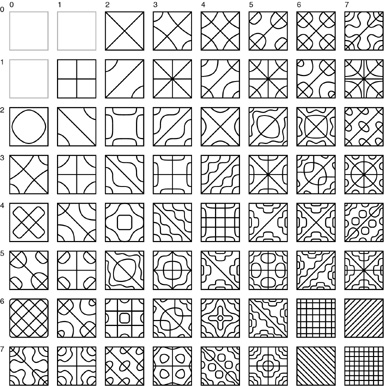
| Back | Return to Beginning | Next |
This figure shows the many standing wave patterns that can emerge from a square steel plate, by bowing with a violin bow, as demonstrated by Chladni. The plate emits an acoustical tone when bowed in this manner, and each of the patterns shown in the figure corresponds to a unique temporal frequency, or musical pitch, the lowest tones being produced by the patterns with fewer large segments shown at the upper-left, while higher tones are produced by the higher harmonics depicted towards the lower right in the figure. The higher harmonics represent higher energies of vibration, and are achieved by damping closer to the central clamp point, as well as by more vigorous bowing.

Each individual pattern is associated with a unique temporal frequency of oscillation, or audible tone. Therefore an audio recording of the vibrating steel plate could be used to uniquely identify which pattern was present on the plate during recording. Furthermore, an audio playback of that frequency in the presence of the plate would have the effect of regenerating that same pattern of resonance back on the original plate. The audio tone can therefore be considered as an abstracted representation, or reduced dimensionality encoding of the spatial pattern on the plate, like the activation of a cell body in a neural network model. The item in the resonance model corresponding to the cell body in the receptive field model can be envisaged as some kind of tuned resonator, perhaps a cell with a natural tendency to spike at a characteristic frequency tuned to one of the harmonics of the plate.
| Back | Return to Beginning | Next |